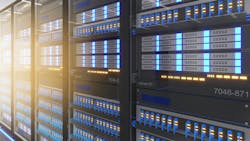In a recent interview, Ray Walsh, Program Director of Data Center Cooling for MOOG, spoke to Matt Vincent, Editor-in-Chief of Data Center Frontier, about intelligent motion control, cooling systems and MOOG’s plans for the future.
Matt Vincent:
Can you tell us how MOOG originated and how its expertise in other industries influenced its data center capabilities?
Ray Walsh:
MOOG is, at its core, a fluid control company. Its origins are in aerospace and space applications, founded in the early 1950s by a gentleman called Bill Moog. He invented a revolutionary product, which today we call the servo valve. That gave industry an ability to precisely control fluids. In his case, he was focused on hydraulic fluids that control aircraft flight surfaces, missile fin controls and so on. Over the last 75 years, we have progressed through a variety of different industries, including aerospace, space, defense, industrial and medical. If you look out the window of a modern aircraft and see any of the surfaces moving, MOOG hardware is moving them, whether it be a Boeing, Airbus or Embraer plane.
Vincent:
Given MOOG's legacy in designing and manufacturing motion control products, what drove the decision to enter the data center market?
Walsh:
I think there were two factors. One thing that's a little bit unusual about MOOG is that we are very much collaborative with our customers—we pride ourselves on engaging with customers. We found ourselves in a scenario about a decade ago where we had a pioneering data center equipment provision company that was looking to move from air cooling to fluid cooling. We had been providing them some air cooling products and the customer who was trying to break new ground. Our collaboration led to the development of a series of different pumps for that customer, and that was the start of MOOG’s data center products.
Vincent:
How do intelligent cooling controls and maintenance services contribute to overall data center sustainability?
Walsh:
I think there are a couple of facets to that question. Let’s start with intelligent controls. Servo drives, which ultimately cause the pump to run, have electronics baked into them that look at various key characteristics of the pump operation. That could be the amount of power it's consuming, its running temperature, the pressure it's seeing, and so on. Those should all operate within certain predefined confines. We're able to monitor and communicate that information back to a data center operator. This allows us to flag something going wrong early, giving you the ability to provide some prognostic data into the management of the data center itself, where you can intervene before something has truly become a problem.
The other side of it is maintenance and sustainability. Our pumps started out life as data center pumps—we designed them with that specific set of requirements in mind, and I think that does separate us a little bit from the industry. There are lots of very fine products on the market, but they are products that had a generic product evolution. We've been able to optimize size and performance. We were able to look at the key things that data centers care about—uptime, lack of maintenance—and we've been able to bake that into our product from the beginning.
For example, our pumps have no rotating seals, and they run on what we call a pseudo fluid bearing. Theoretically, there are no wear points in our pump, provided it's running within its prescribed characteristic, so there's no scheduled maintenance. They theoretically run forever and there's less cost of ownership. They use a lot less energy as well. From a PUE point of view, our pumps reduce the overhead associated with running a data center. We're moving more fluid per watt than all our competitors, largely because our pump is a designed-for-purpose product.
Vincent:
Can you share any recent advancements or breakthroughs in motion control and cooling systems for data centers?
Walsh:
We've just brought to market our new sensing product. It comes from ultrasonics work we've been doing in the medical industry. We have an ultrasonic sensor that we can now deploy into data centers to measure cavitation, or air bubbles in the fluid. To me, that is one of those things that's very hard to detect normally. If you've got cavitation in your fluids, it's usually a sign that something is going wrong. This sensor provides an early warning.
Again, we strive to make sure that our products are fit for purpose and are also designed for the requirements that the data center operators or hyperscalers really care about. A lot of our competitor products are standard industrial pumps that have been modified. They're designed to live in an industrial environment or a factory. Data center environments are quite different, and I think that gives us an advantage—one that everybody will be looking to achieve as data centers, particularly liquid cooling data centers, become more prevalent.
Vincent:
What key qualities and skill sets define the MOOG team?
Walsh:
I think it's really the DNA of the company that sets us apart. Our tagline is “Shaping the way our world moves,” and that really is about focusing our core value on making motion control more sustainable and doing it the best way that it can be done. The other tagline we have is “Performance really matters.” Those two things are just how we exist as a company.
We spend all our time thinking about solving hard problems. Usually, when people show up at our door, it's not because they want to compare our products to someone else’s catalog. It's that they haven't been able to find a product that really meets their requirements. I go back to the collaborative customer intimacy model that we operate upon. The ‘solving of hard problems and working with customers mindset’ are more of a culture thing, I think. It’s more than just hard skills, because there are very talented engineers and technicians in lots of companies.
Vincent:
How do you see the data center industry evolving in the coming years, and what role does MOOG aim to play in this transformation?
Walsh:
I think the big change is the migration of data centers from air cooling to liquid cooling. That's a mega trend and we’re early in the process. Some of the co-locators haven't gone there yet, but all the hyperscalers are going there. We will see liquid cooling becoming the de facto standard as the chip power densities increase. The racks, the servers, the power density, everything is just going up. You have to have liquid cooling.
From a MOOG perspective, we continue to evolve our pump product lines and I would like to think that we will be a premier supplier of those pumps into data center equipment manufacturers as time goes on. But I think the other piece is related to how our company evolves. We make a product that's really good and then we ask, “what else can we do?” If I go back to our aerospace heritage, we started providing valves to Boeing & Airbus. Today, and this was a long term strategy, we provide all the flight controls from the stick to the tail on a Boeing 787. It's all MOOG hardware.
I see the same thing happening with data centers. We will continue to evolve our capability. We will look at the problems that data center operators and CDU providers face, and we will use our systems capability and knowledge to not just provide a pump, but provide an intelligent pump, a subsystem, or maybe even a partial system. I think that's how our company has always operated. I see no reason why it won't be the same this time around.
About the Author

Ray Walsh
Ray Walsh is Program Director of Data Center Cooling for MOOG.


